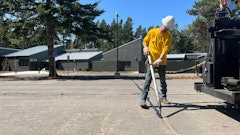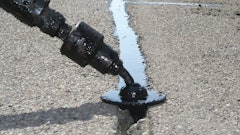
Generally, preservation treatments and pavement overlays are used to restore surface course characteristics such as smoothness, friction and aesthetics, or to add structural support to an existing pavement.
However, any preservation treatment needs to be placed on a structurally sound base. If an existing pavement is cracked or provides inadequate structural support, these defects will often reflect through even the best-constructed overlay and cause premature pavement failure in the form of cracks and deformations. To maximize an overlays useful life, failed sections of the existing pavements should be patched or replaced and existing pavement cracks should be filled.
Crack sealing as a First Step in a Preservation System
Before proceeding with any type of surface treatment, consider what needs to be done to the cracks. Cracks are going to happen in asphalt pavement, and when they do it's your job to stop them from deteriorating the surface and creating potholes.
What: Crack sealing/filling is usually done with liquid asphalt, cutbacks or emulsions and is considered only a temporary procedure. The process seals cracks against moisture and debris.
Where: Crack sealing maintains a tightly sealed crack only as long as the pavement remains stationary and the pavement is structurally sound. In climates with extreme temperatures, where expansion and contraction occurs often, resealing may be necessary every year. Sealing and filling should be done only on dry surfaces and when the temperature is above 40 F°. (Cooler temperatures cause the pavement to contract, opening the crack and making it easier to fill properly.) Traffic should not be allowed on the sealed cracks until sealant has cured.
Why: Cracking is a pretty common and unavoidable type of damage found in asphalt pavement. The Asphalt Institute indicates that crack sealing/filling is the single most important pavement maintenance activity. Sealing cracks promptly helps to prevent water penetration which can accelerate the deterioration of the pavement and result in potholes and base failures.
Why not: According to the Asphalt Institute, sealing and filling cracks should not be done on a pavement that has significant structural problems as crack repair does not provide any structural improvement to the pavement. If the pavement has base failures, severe rutting or fatigue (alligator) cracking, crack sealing/filling is not an appropriate preservation option.
Preservation prognosis: Crack sealing/filling can extend the life of the pavement 3-4 years when used on pavements in good condition, 0-2 years for pavement in poor condition.
When Crack Repair Isn’t Enough
Selecting the appropriate crack repair method depends upon the type and severity of cracks. Badly cracked pavement sections, especially those with pattern cracking (e.g., fatigue cracking) or severe slab cracks, must be patched or replaced because these distresses are often symptoms of more extensive pavement or subgrade structural failure.
Cracks other than those symptomatic of structural failure should be cleaned out (blown out with pressurized air and/or swept) and filled with a crack sealing material when the cracks are clean and dry. Cracks less than ¼-in. in width are probably too narrow for crack sealing material to enter. These narrow cracks can be widened with a mechanical router before sealing.
If the existing pavement has an excessive amount of fine cracks but is still structurally adequate, it may be more economical to apply a general bituminous surface treatment (BST) or slurry seal instead of filling each individual crack.
Excessive crack sealing should always be avoided. If the sealant quantity is greater than 5,000-lbs. per lane mile, other treatments such as thicker overlays or milling, interlayer or surface treatments in conjunction with an overlay may be more appropriate.




















